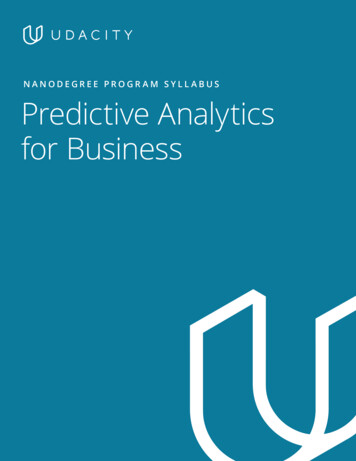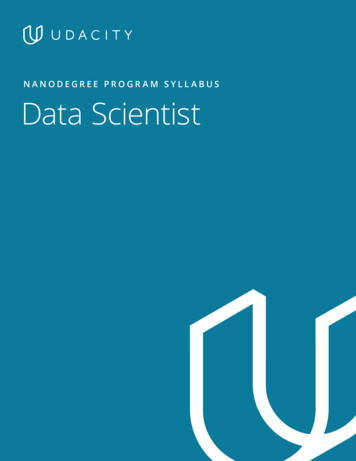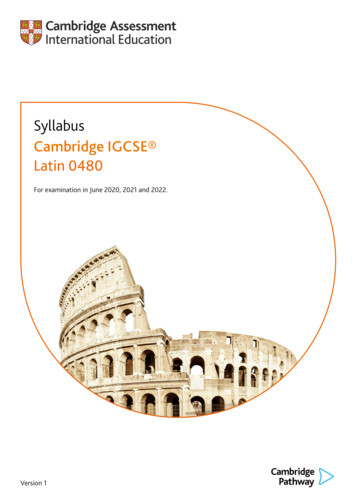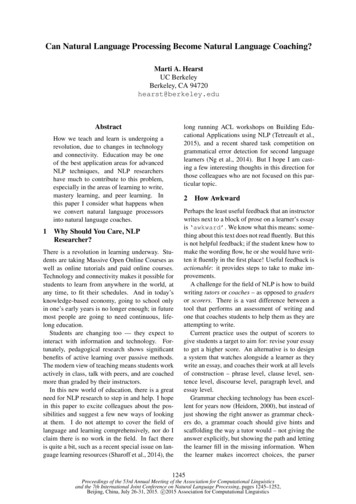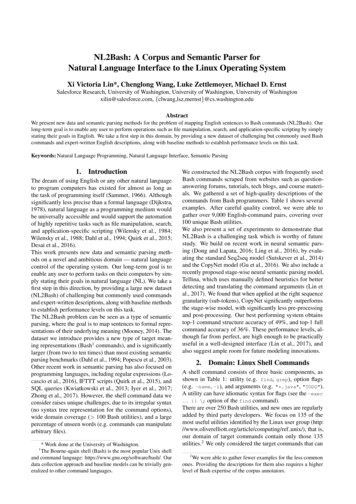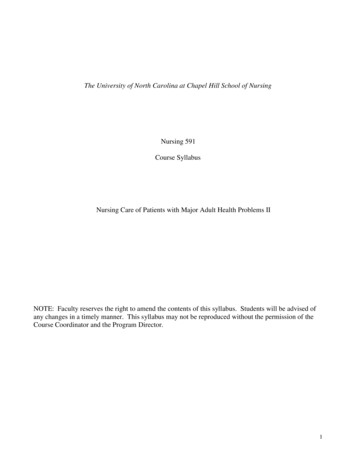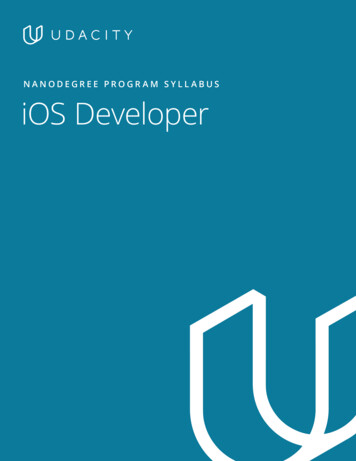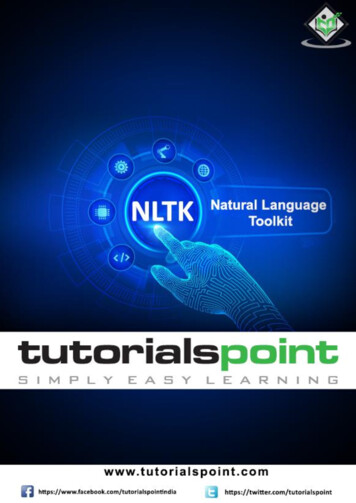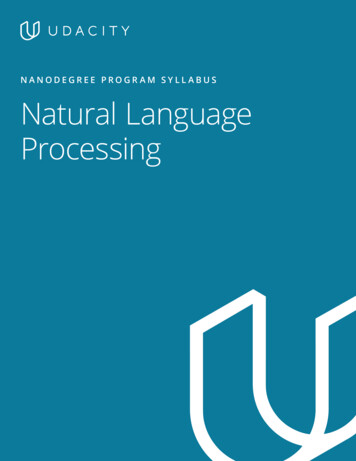
Transcription
NANODEGREE PROGR AM SYLL ABUSNatural LanguageProcessing
OverviewThis program will enhance your existing machine learning and deep learning skills with the addition ofnatural language processing and speech recognition techniques. These skills can be used in variousapplications such as part of speech tagging and machine translation, among others. You’ll develop the skillsyou need to start applying natural language processing techniques to real-world challenges andapplications.The program is comprised of 3 courses and 3 projects. Each project you build will be an opportunity todemonstrate what you’ve learned in your lessons. Your completed projects become part of a careerportfolio that will demonstrate your mastery of natural language processing to prospective employers.I N CO L L A B O R AT I O N W I T HEstimated Time:3 Months at10hrs/weekFlexible Learning:Self-paced, soyou can learn onthe schedule thatworks best for youPrerequisites:Python, Statistics,Machine Learning,& Deep LearningTechnical MentorSupport:Our knowledgeablementors guide yourlearning and arefocused on answeringyour questions,motivating you andkeeping you on trackNatural Language Processing Expert 2
Course 1: Introduction to Natural LanguageProcessingLearn text processing fundamentals, including stemming and lemmatization. Explore machine learningmethods in sentiment analysis. Build a speech tagging model.Use several techniques, including table lookups, n-grams, andhidden Markov models, to tag parts of speech in sentences, andcompare their performance.Course ProjectPart of Speech TaggingThis project demonstrates text processing techniques that allow youto build a part of speech tagging model. You will work with a simplelookup table, and progressively add more complexity to improve themodel using probabilistic graphical models. Ultimately you’ll beusing a Python package to build and train a tagger with a hiddenMarkov model, and you will be able to compare the performances ofall these models in a dataset of sentences.LEARNING OUTCOMESIntro to NLP Learn the main techniques used in natural languageprocessing. Get familiarized with the terminology and the topics in theclass. Build your first application with IBM Watson.LESSON TWOText Processing See how text gets processed in order to use it in models. Learn techniques such as tokenization, stemming, andlemmatization. Get started with part of speech tagging and named entityrecognition.LESSON THREEPart of SpeechTagging with HiddenMarkov Models Learn how hidden Markov models are defined. Train HMMs with the Viterbi and the Baum-Welchalgorithms. Use HMMs to build a part of speech tagging model.LESSON ONENatural Language Processing Expert 3
Course 2: Computing with Natural LanguageLearn advanced techniques like word embeddings, deep learning attention, and more. Build a machinetranslation model using recurrent neural network architectures.Course ProjectMachine TranslationBuild a deep neural network that functions as part of an end-to-endmachine translation pipeline. Your completed pipeline will acceptEnglish text as input and return the French translation. You’ll beable to explore several recurrent neural network architectures andcompare their performance.First you will preprocess the data by converting text to sequenceof integers. Then you will build several deep learning models fortranslating the text into French. As a final step, you will run thismodels on English test to analyze their performance.LEARNING OUTCOMESLESSON ONEFeature Extractionand Embeddings Learn to extract features from text. Learn the most used embedding algorithms, such asWord2Vec and Glove.LESSON TWOModeling Learn about the main uses of deep learning models in NLP. Learn about machine translation, topic models, andsentiment analysis.LESSON THREEDeep LearningAttention Learn about attention, the advanced deep learning methodempowering applications like Google Translate. Learn about additive and multiplicative attention inapplications like machine translation, text summarization,and image captioning. Learn about cutting edge deep learning models like TheTransformer that extend the use of attention to eliminatethe need for RNNs.LESSON FOURInformation Systems Learn about information extraction and informationretrieval systems. Learn about question answering and its applications.Natural Language Processing Expert 4
Course 3: Communicating with NaturalLanguageLearn voice user interface techniques that turn speech into text and vice versa. Build a speech recognitionmodel using deep neural networks.Course ProjectSpeech RecognizerBuild a deep neural network that functions as part of an end-to-endautomatic speech recognition (ASR) pipeline. The model will convertraw audio into feature representations, which will then turn theminto transcribed text.You’ll begin by investigating a dataset, that will be used to train andevaluate your models. Your algorithm will first convert any raw audioto feature representations that are commonly used for ASR. You willthen build neural networks that map these features to transcribedtext.LEARNING OUTCOMESLESSON ONELESSON TWOLESSON THREEIntro to Voice UserInterfaces Learn the basics of how computers understand spokenwords. Get familiar with the most common VUI applications. Set up your AWS account and build Alexa skill with anexisting template.Alexa History SKill Learn the basics of Amazon AWS. Create your own fully functional Alexa skill using Amazon’sAPI. Deploy your skill for everyone to use it.Introduction toSpeech Recognition Learn the pipeline used for speech recognition. Learn to process and extract features from sound signals. Learn to build probabilistic and machine learning Languagemodels in order to extract words and grammar from soundsignals.Natural Language Processing Expert 5
Our Classroom ExperienceREAL-WORLD PROJECTSBuild your skills through industry-relevant projects. Getpersonalized feedback from our network of 900 projectreviewers. Our simple interface makes it easy to submityour projects as often as you need and receive unlimitedfeedback on your work.KNOWLEDGEFind answers to your questions with Knowledge, ourproprietary wiki. Search questions asked by other students,connect with technical mentors, and discover in real-timehow to solve the challenges that you encounter.WORKSPACESSee your code in action. Check the output and quality ofyour code by running them on workspaces that are a partof our classroom.QUIZZESCheck your understanding of concepts learned in theprogram by answering simple and auto-graded quizzes.Easily go back to the lessons to brush up on conceptsanytime you get an answer wrong.CUSTOM STUDY PLANSCreate a custom study plan to suit your personal needsand use this plan to keep track of your progress towardyour goal.PROGRESS TRACKERStay on track to complete your Nanodegree program withuseful milestone reminders.Natural Language Processing Expert 6
Learn with the BestLuis SerranoJay AlammarC U R R I C U LU M L E A DI N S T R U C TO RLuis was formerly a Machine LearningEngineer at Google. He holds a PhD inmathematics from the University ofMichigan, and a Postdoctoral Fellowshipat the University of Quebec at Montreal.Reto Meier has been part of AndroidDeveloper Relations at Google since 2009,and leads Google’s Scalable DeveloperAdvocacy team. He is the author ofthe “Professional Android ApplicationDevelopment” book series from Wrox.Arpan ChakrabortyDana SheahenI N S T R U C TO RCO N T E N T D E V E LO P E RArpan is a computer scientist with a PhDfrom North Carolina State University. Heteaches at Georgia Tech (within the Masters in Computer Science program), andis a coauthor of the book Practical GraphMining with R.Dana is an electrical engineer with aMasters in Computer Science from GeorgiaTech. Her work experience includessoftware development for embeddedsystems in the Automotive Group atMotorola, where she was awarded a patentfor an onboard operating system.Natural Language Processing Expert 7
All Our Nanodegree Programs Include:EXPERIENCED PROJECT REVIEWERSREVIEWER SERVICES Personalized feedback & line by line code reviews 1600 Reviewers with a 4.85/5 average rating 3 hour average project review turnaround time Unlimited submissions and feedback loops Practical tips and industry best practices Additional suggested resources to improveTECHNICAL MENTOR SUPPORTMENTORSHIP SERVICES Questions answered quickly by our team oftechnical mentors 1000 Mentors with a 4.7/5 average rating Support for all your technical questionsPERSONAL CAREER SERVICESC AREER SUPPORT Github portfolio review LinkedIn profile optimizationNatural Language Processing Expert 8
Frequently Asked QuestionsPROGR AM OVERVIE WWHY SHOULD I ENROLL?This program offers a deep dive into modern Natural Language Processtechniques. Mastering these skills will prepare you to build applicationsinvolving written and spoken language. We’ve collaborated with leadinginnovators such as IBM and Amazon to create our world-class curriculum,and you’ll learn from an instructor team comprised of experts from bothUdacity and industry professionals. Massive growth is being predicted for theNatural Language Processing software market, making now the perfect timeto enter this field.WHAT JOBS WILL THIS PROGRAM PREPARE ME FOR?In this program, you’ll develop and refine specialized skills in natural languageprocessing and voice user interfaces. The curriculum is not designed toprepare you for a specific job; instead, the goal is that you’ll expand your skillsin the natural language processing domain. Growth predictions are extremelyhigh for this market, and having these in-demand skills will significantlyenhance your ability to advance your AI career.HOW DO I KNOW IF THIS PROGRAM IS RIGHT FOR ME?If your goal is to become an expert in Natural Language Processing (NLP),this program is ideal for you. Over the course of this program, you’ll becomean expert in the main components of NLP, including speech recognition,sentiment analysis, and machine translation. You’ll learn cutting edgeprobabilistic and deep learning models, code them and train them on realdata, and build a career-ready portfolio as an NLP expert!ENROLLMENT AND ADMISSIONDO I NEED TO APPLY? WHAT ARE THE ADMISSION CRITERIA?There is no application. This Nanodegree program accepts everyone,regardless of experience and specific background.WHAT ARE THE PREREQUISITES FOR ENROLLMENT?To succeed in this Nanodegree program, we recommend you first takeany course in Deep Learning equivalent to our Deep Learning Nanodegreeprogram. You also need to be able to communicate fluently andprofessionally in written and spoken English.Additionally, you should have the following knowledge:Intermediate Python programming knowledge, including: Strings, numbers, and variables Statements, operators, and expressionsNatural Language Processing Expert 9
FAQs Continued Lists, tuples, and dictionaries Conditions & loops Generators & comprehensions Procedures, objects, modules, and libraries Troubleshooting and debugging Research & documentation Problem solving Algorithms and data structuresBasic shell scripting: Run programs from a command line Debug error messages and feedback Set environment variables Establish remote connectionsBasic statistical knowledge, including: Populations, samples Mean, median, mode Standard error Variation, standard deviations Normal distributionIntermediate differential calculus and linear algebra, including: Derivatives & Integrals Series expansions Matrix operations through eigenvectors and eigenvaluesYou will need to be able to communicate fluently and professionally in writtenand spoken English.IF I DO NOT MEET THE REQUIREMENTS TO ENROLL, WHAT SHOULD I DO?We have a number of courses and programs we can recommend that will helpprepare you for the program, depending on the areas you need to address.For example: Intro to Machine Learning Intro to Data Science Intro to Programming Nanodegree program Data Analyst Nanodegree program Artificial Intelligence Programming with Python Nanodegree program Deep Learning Nanodegree program Machine Learning Engineer Nanodegree programTUITION AND TERM OF PROGR AMHOW IS THIS NANODEGREE PROGRAM STRUCTURED?The Natural Language Processing Nanodegree program is comprised ofcontent and curriculum to support three (3) projects. We estimate thatNatural Language Processing Expert 10
FAQs Continuedstudents can complete the program in three (3) months, working 10 hoursper week.Each project will be reviewed by the Udacity reviewer network. Feedback willbe provided and if you do not pass the project, you will be asked to resubmitthe project until it passes.HOW LONG IS THIS NANODEGREE PROGRAM?Access to this Nanodegree program runs for the length of time specified inthe payment card above. If you do not graduate within that time period, youwill continue learning with month to month payments. See the Terms of Useand FAQs for other policies regarding the terms of access to our Nanodegreeprograms.I HAVE GRADUATED FROM THE NATURAL LANGUAGE PROCESSINGNANODEGREE PROGRAM BUT I WANT TO KEEP LEARNING. WHERESHOULD I GO FROM HERE?If you would like to explore other applications for convolutional and recurrentneural networks, and have an interest in computer vision, then considerenrolling in the Computer Vision Nanodegree program. If you are lookingfor additional advanced topics in AI, the Robotics Engineer and Self-DrivingCar Engineer Nanodegree programs could be ideal for you. And regardlessof your future career destination, you’ll find that the Artificial IntelligenceNanodegree program is full of valuable content that will serve you well inalmost any AI role.SOF T WARE AND HARDWAREWHAT SOFTWARE AND VERSIONS WILL I NEED IN THIS PROGRAM?You will need a computer running a 64-bit operating system (most modernWindows, OS X, and Linux versions will work) with at least 8GB of RAM,along with administrator account permissions sufficient to install programsincluding Anaconda with Python 3.5 and supporting packages. Your networkshould allow secure connections to remote hosts (like SSH). We will provideyou with instructions to install the required software packages. Udacity doesnot provide any hardware or software.Natural Language Processing Expert 11
Learn to extract features from text. Learn the most used embedding algorithms, such as Word2Vec and Glove. LESSON TWO Modeling Learn about the main uses of deep learning models in NLP. Learn about machine translation, topic models, and sentiment analysis. LESSON THREE Deep Learning Attention

